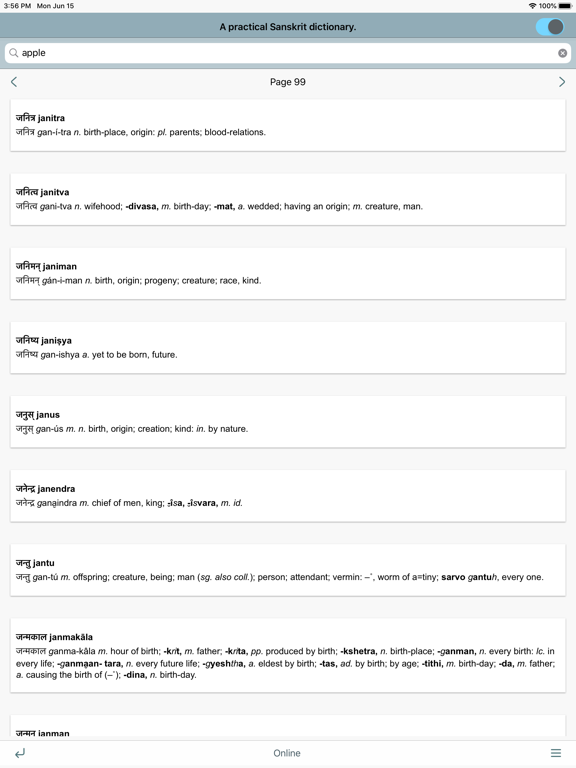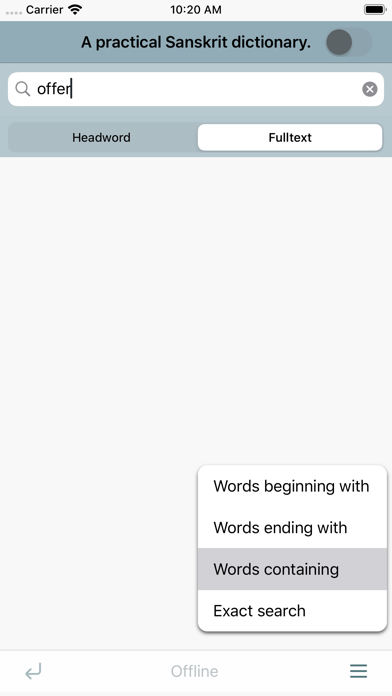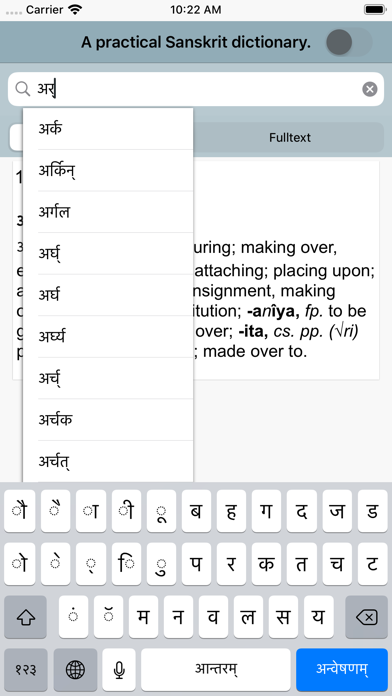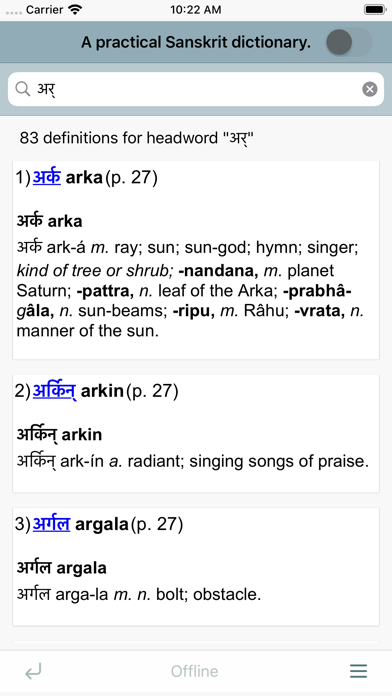
DDSA Practical Sanskrit
Macdonell Sanskrit dictionary
無料
1.0for iPhone, iPad and more
7.3
3 Ratings
The University of Chicago
Developer
23.2MB
Size
2020年06月18日
Update Date
Reference
Category
4+
Age Rating
Age Rating
DDSA Practical Sanskrit スクリーンショット
About DDSA Practical Sanskrit
The Macdonell Practical Sanskrit Dictionary app is a product of the Digital South Asia Library program (https://dsal.uchicago.edu) at the University of Chicago. The app offers a searchable version of Macdonell, Arthur Anthony, "A practical Sanskrit dictionary with transliteration, accentuation, and etymological analysis throughout," London: Oxford University Press, 1929. "The original edition of this dictionary was published by Messrs. Longmans, Green & co., and has been reproduced photographically with their consent."
The Macdonell Practical Sanskrit Dictionary app can be used both online and offline. The online version interacts with a database that runs remotely on a server at the University of Chicago. The offline version uses a database that is created on the device upon first download.
By default, the app operates in the online mode.
The app allows users to conduct both headword and fulltext queries.
The default mode for this app is to search headwords. To search for a headword, touch the search box at the top (magnifying glass icon) to expose the on-screen keyboard and begin searching. Headwords can be entered in Sanskrit, accented latin characters, and unaccented latin characters.
After entering three characters in the search box, a scrollable list of search suggestions will pop up. Touch the word to search for and it will automatically fill in the search field. Or ignore suggestions and enter the search term completely. To execute the search, touch the return button on the keyboard.
By default, headword searches expand off the end of the search term. In other words, searching for "kar" will generate results for headwords that begin with "kar" and have any number of trailing characters, like "karanda" (करण्ड), "karaṅka" (करङ्क), "karîra" (करीर), etc. To expand the front of a query, users can enter the "%" character at the beginning of search term. For example, "%kar" will find "á-karna" (अकर्ण), "a-kâraka" (अकारक), "agni-kârya" (अग्निकार्य), etc. The wildcard character at the front of a word also expands search suggestions.
For fulltext searching, select the "Fulltext" search scope button and then enter the search term in the search box at the top.
For example, the search "temple fire" returns 4 results where "temple" and "fire" can be found in the same definition. Multiword searches can be executed with the boolean operators "NOT" and "OR" as well. The search "temple OR fire" returns 319 fulltext results; "temple NOT fire" returns 93 fulltext results.
To conduct substring matching, select an option from the "Search Options" sub-menu, enter a string in the search field, and touch return. The default for all searching is "Words beginning with." But for example, selecting "Words ending with," "Search all text," and then entering "sant" as the search string will find 96 examples of words that end in "sant."
Search results come first in a numbered list that displays the Sanskrit headword, the accented latin transliteration of the headword, and a chunk of the definition. To see a full definition, touch the headword.
In online mode, the full result page also has a page number link that the user can click to get the full page context of the definition. Link arrows at the top of the full page allow the user to click to previous and next pages in the dictionary.
To select either online or offline mode, simply toggle the selector at the top of the screen.
Note that on start up, the app will test to see whether the device has an internet connection and the remote server is available. Again, the app operates in online mode by default. The user should select the appropriate mode before conducting a search.
The Macdonell Practical Sanskrit Dictionary app can be used both online and offline. The online version interacts with a database that runs remotely on a server at the University of Chicago. The offline version uses a database that is created on the device upon first download.
By default, the app operates in the online mode.
The app allows users to conduct both headword and fulltext queries.
The default mode for this app is to search headwords. To search for a headword, touch the search box at the top (magnifying glass icon) to expose the on-screen keyboard and begin searching. Headwords can be entered in Sanskrit, accented latin characters, and unaccented latin characters.
After entering three characters in the search box, a scrollable list of search suggestions will pop up. Touch the word to search for and it will automatically fill in the search field. Or ignore suggestions and enter the search term completely. To execute the search, touch the return button on the keyboard.
By default, headword searches expand off the end of the search term. In other words, searching for "kar" will generate results for headwords that begin with "kar" and have any number of trailing characters, like "karanda" (करण्ड), "karaṅka" (करङ्क), "karîra" (करीर), etc. To expand the front of a query, users can enter the "%" character at the beginning of search term. For example, "%kar" will find "á-karna" (अकर्ण), "a-kâraka" (अकारक), "agni-kârya" (अग्निकार्य), etc. The wildcard character at the front of a word also expands search suggestions.
For fulltext searching, select the "Fulltext" search scope button and then enter the search term in the search box at the top.
For example, the search "temple fire" returns 4 results where "temple" and "fire" can be found in the same definition. Multiword searches can be executed with the boolean operators "NOT" and "OR" as well. The search "temple OR fire" returns 319 fulltext results; "temple NOT fire" returns 93 fulltext results.
To conduct substring matching, select an option from the "Search Options" sub-menu, enter a string in the search field, and touch return. The default for all searching is "Words beginning with." But for example, selecting "Words ending with," "Search all text," and then entering "sant" as the search string will find 96 examples of words that end in "sant."
Search results come first in a numbered list that displays the Sanskrit headword, the accented latin transliteration of the headword, and a chunk of the definition. To see a full definition, touch the headword.
In online mode, the full result page also has a page number link that the user can click to get the full page context of the definition. Link arrows at the top of the full page allow the user to click to previous and next pages in the dictionary.
To select either online or offline mode, simply toggle the selector at the top of the screen.
Note that on start up, the app will test to see whether the device has an internet connection and the remote server is available. Again, the app operates in online mode by default. The user should select the appropriate mode before conducting a search.
Show More
最新バージョン 1.0 の更新情報
Last updated on 2020年06月18日
Version History
1.0
2020年06月18日
DDSA Practical Sanskrit FAQ
ここをクリック!地理的に制限されているアプリのダウンロード方法をご参考ください。
次のリストをチェックして、DDSA Practical Sanskritの最低システム要件をご確認ください。
iPhone
iOS 13.0以降が必要です。
iPad
iPadOS 13.0以降が必要です。
iPod touch
iOS 13.0以降が必要です。
DDSA Practical Sanskritは次の言語がサポートされています。 英語
































